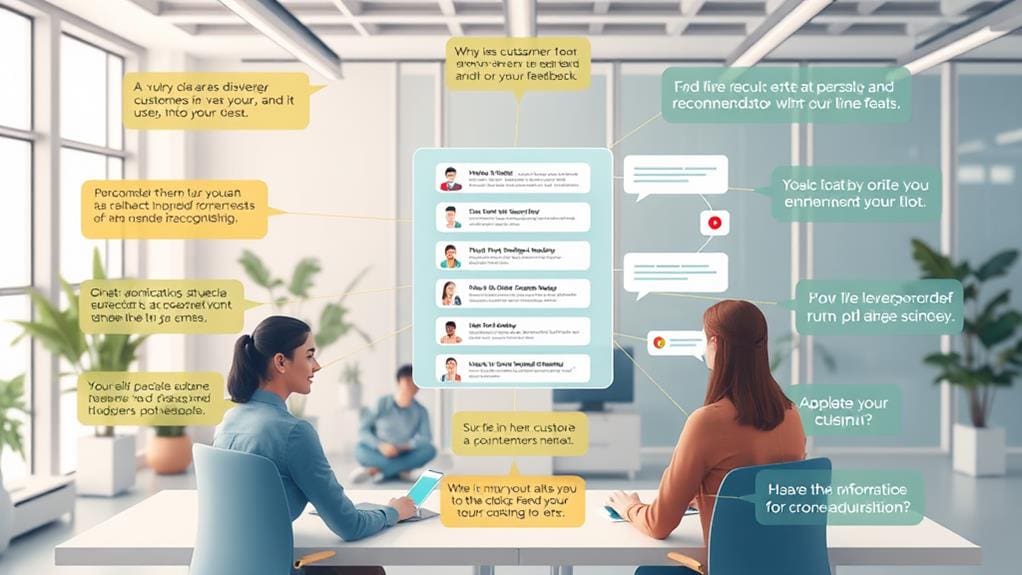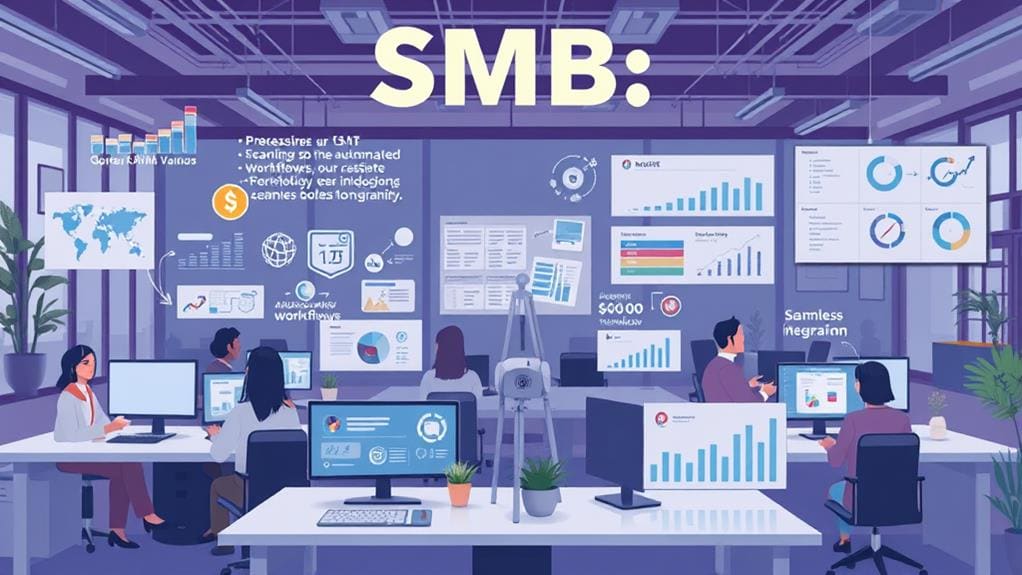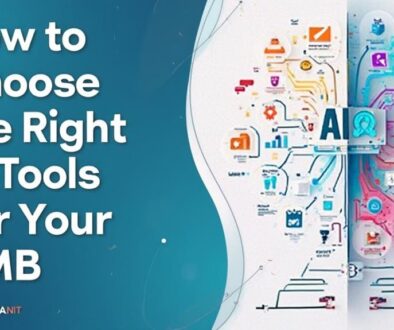The Power of AI in Enhancing SMB Operational Efficiency
AI plays an essential role in enhancing operational efficiency for small and medium-sized businesses (SMBs) by automating routine tasks and optimizing resource allocation. This technology streamlines workflows, reduces error rates, and boosts productivity, allowing teams to focus on strategic initiatives. Through improved customer interactions and data-driven decision-making, AI fosters greater agility and responsiveness to market demands. Additionally, cost reduction strategies facilitated by AI guarantee that SMBs can operate within budget while enhancing service delivery. Overall, the thoughtful implementation of AI in SMBs presents significant opportunities for driving growth and efficiency, with further insights available on the subject.
Key Takeaways
- AI-driven automation improves time management and productivity by streamlining repetitive tasks, allowing teams to focus on strategic initiatives.
- Personalized customer interactions through AI enhance engagement, improving service efficiency and fostering customer loyalty.
- Predictive analytics tools aid SMBs in making informed decisions by forecasting market trends and analyzing customer behavior.
- Cost reduction strategies via automation aggregate savings, optimize budgets, and ensure scalable operational efficiency.
- Successful case studies demonstrate the transformative impact of AI in enhancing operational efficiency across various SMB sectors.
Understanding AI for SMBs

Many small and medium-sized businesses (SMBs) are increasingly recognizing the transformative potential of artificial intelligence (AI) in streamlining operations and enhancing productivity. Understanding AI fundamentals is vital for SMB leaders to effectively navigate their unique challenges.
These businesses often grapple with issues such as limited resources, scalability solutions, and the need for customized AI tools that align with their operational goals.
To overcome these SMB challenges, effective implementation strategies must be devised. This includes selecting the right AI tools that not only meet specific business needs but also seamlessly integrate with existing systems. Integration issues can impede the potential productivity gains, making it significant to carefully assess compatibility with current technology stacks.
Moreover, AI best practices play a pivotal role in technology adoption among SMBs. Establishing robust training programs guarantees that employees are equipped with the necessary skills to leverage AI tools effectively. Emphasizing data security also becomes paramount as businesses increasingly rely on data-driven decisions.
The journey towards AI integration requires a thoughtful approach, tackling both technical and human-centric concerns. By prioritizing these areas, SMBs can build a solid foundation that promotes successful AI implementation.
This structured understanding of AI not only positions SMBs to address immediate operational inefficiencies but also empowers them for sustained growth in an evolving digital landscape. As these businesses commence their AI journey, awareness of the aforementioned factors remains essential for maximizing potential and securing resilience in the face of rapid technological advancements.
Benefits of AI-Driven Automation
AI-driven automation offers significant advantages for small and medium-sized businesses by enhancing time savings and productivity across operations.
By implementing intelligent systems, companies can identify cost reduction strategies and allocate resources more effectively, ultimately leading to improved profitability.
Additionally, automated processes streamline workflows, minimize error rates, and enable a more agile response to market demands, cementing the role of AI as a pivotal component in operational efficiency.
Time Savings and Productivity
Efficiency is increasingly becoming a cornerstone of competitive advantage in the landscape of small and medium-sized businesses (SMBs). AI-driven automation presents an opportunity to enhance time management considerably, allowing businesses to redirect focus from mundane tasks to strategic initiatives that drive growth.
By automating routine workflows, SMBs can minimize administrative burdens, effectively improving employee satisfaction and morale.
Implementing AI-powered productivity tools enables the optimization of processes such as customer relationship management, data entry, and inventory control. These tools facilitate accurate task execution, often at speeds unattainable by manual efforts. As a result, workflows are streamlined, leading to notable time savings.
Moreover, the integration of AI enhances decision-making capabilities. By analyzing large datasets in real-time, AI can provide valuable insights that help businesses prioritize tasks and manage schedules more effectively.
This improved time management not only enhances individual productivity but also fosters a collaborative environment where team members can contribute their skills towards higher-value work.
Cost Reduction Strategies
Frequently, businesses overlook the substantial potential for cost reduction that comes with implementing automation technologies. By strategically leveraging AI, small and medium-sized businesses can achieve significant budget optimization and enhance resource allocation. This optimization allows for an effective reallocation of funds toward vital areas, fostering innovation and growth.
Investing in technology not only streamlines existing processes but also guarantees operational scalability, enabling businesses to scale up or down flexibly based on market demands. Additionally, fostering strong vendor partnerships can lead to lower costs and enhanced services, reinforcing a competitive edge.
Effective risk management is essential in this endeavor. AI can assist in evaluating financial risks and generating data-driven insights that facilitate informed decision-making. Regular process evaluation guarantees that automation tools are tailored to specific operational needs, minimizing waste and redundancy.
Moreover, prioritizing workforce training in AI technologies equips employees with the skills required to adapt seamlessly, ensuring that the organization maximizes its technology investment.
Collectively, these strategies highlight the transformative impact of AI-driven automation in reshaping operational landscapes, ultimately leading to marked reductions in costs while enhancing overall business agility.
Streamlined Processes and Workflows
While many businesses struggle with complex and time-consuming processes, the integration of automation technologies offers a transformative solution that enhances workflows and operational coherence.
AI-driven automation facilitates process optimization by refining existing procedures, enabling employees to focus on higher-value tasks. Consequently, the efficiency of operations improves considerably.
Key benefits of workflow automation include:
- Increased Productivity: By automating routine tasks, businesses can guarantee that employees are not bogged down by repetitive activities, leading to a notable boost in productivity levels.
- Error Reduction: Automation minimizes the potential for human error, which can have substantial impacts on business performance and customer satisfaction. Enhanced accuracy contributes to a more reliable output.
- Time Savings: Streamlined processes save valuable time. With AI managing repetitive and mundane tasks, teams can allocate their efforts towards strategic initiatives that drive growth.
Incorporating these technologies into operational systems not only conveys confidence in efficiency but also aligns with the desire for freedom from laborious processes, fostering an innovative environment conducive to growth and agility within small and medium-sized businesses.
Enhancing Customer Interactions

Effective customer interactions represent an essential pillar in the operational strategies of small and medium-sized businesses (SMBs). The integration of artificial intelligence (AI) into these interactions enables a transformative shift toward more personalized communication, greatly enhancing customer experience and engagement. By leveraging AI-driven tools, SMBs can guarantee that their communication is tailored to meet the unique needs of each customer, fostering stronger relationships and improving overall satisfaction.
Automated responses powered by AI greatly streamline support efficiency, guaranteeing timely engagement while simultaneously reducing the workload on customer service teams. This allows businesses to allocate resources more strategically, directing human agents toward complex inquiries that require nuanced relationship management.
In addition, interaction analytics provide valuable insights into customer behavior, preferences, and feedback, equipping SMBs to refine their engagement strategies effectively. By analyzing patterns from customer feedback, SMBs can implement service personalization that resonates with their clientele. This not only enhances the customer experience but also cultivates loyalty, as consumers increasingly seek businesses that understand and cater to their specific needs.
Incorporating AI into customer interactions empowers SMBs to establish a dynamic feedback loop that facilitates continuous improvement. The outcome is not merely an increase in operational efficiency; it is the creation of a vibrant ecosystem where customers feel valued and understood.
As a result, embracing AI technologies allows SMBs to turn customer interactions into meaningful engagements, ultimately driving growth and sustainability in an increasingly competitive landscape.
Data Analysis for Informed Decisions
Informed decision-making is paramount for small and medium-sized businesses (SMBs) maneuvering the complexities of today's market. The integration of AI into data analysis processes greatly enhances an SMB's ability to interpret vast amounts of information, facilitating strategically sound choices.
With tools like predictive analytics, businesses can forecast market trends and customer behaviors, allowing them to anticipate needs, optimize stock levels, and personalize offerings.
To effectively harness data analysis capabilities, SMBs should focus on the following strategies:
- Utilizing Data Visualization Techniques: By employing advanced data visualization techniques, SMBs can transform raw data into intuitive graphics. This not only aids in easier interpretation but also allows stakeholders to grasp trends and insights rapidly.
- Adopting Predictive Analytics Tools: These tools enable businesses to analyze historical data patterns and predict future outcomes. For instance, by understanding customer behavior trends, businesses can tailor marketing strategies that resonate more deeply with their target audience.
- Implementing Real-time Data Monitoring: Continuous monitoring of data enables swift adjustments to operational strategies, ensuring SMBs remain competitive in fast-paced environments. By leveraging real-time insights, businesses can respond to shifting market dynamics promptly and effectively.
Cost Savings Through AI Integration

Achieving cost savings through AI integration presents a significant opportunity for small and medium-sized businesses (SMBs) to enhance their financial performance and operational efficiency. By strategically implementing AI tools, SMBs can streamline processes, reduce overhead costs, and allocate their budgets more effectively.
However, the initial phases of AI integration are often fraught with implementation challenges that can inhibit immediate cost benefits. Addressing these challenges involves careful vendor selection to guarantee compatibility with existing systems and scalability options that allow for future growth.
Additionally, establishing clear integration timelines is vital to minimize disruption to day-to-day operations. Once integrated, organizations can utilize performance metrics to assess the impact of AI tools on their operational expenses, guiding informed decisions about ROI measurement.
Training requirements for staff to effectively use these AI solutions can initially seem intimidating, but they are essential for maximizing benefits. Investing in employee education not only mitigates the learning curve but also strengthens the overall effectiveness of AI implementation.
Moreover, comparing results against industry benchmarks can provide SMBs with insights to refine their strategies, guaranteeing alignment with best practices. Ultimately, the ability to measure the long-term benefits of AI—after overcoming short-term hurdles—will demonstrate its value.
With a focus on structured budget allocation and continuous performance evaluation, SMBs can realize substantial cost savings while maintaining the agility that allows them to innovate and compete effectively in their respective markets.
Case Studies of Successful Implementation
The implementation of AI in small and medium-sized businesses (SMBs) has yielded notable success stories that highlight its potential to enhance operational efficiency. However, these successes come in the wake of various AI adoption challenges, making the narratives all the more compelling.
Examining case studies can provide valuable insights into how SMBs can achieve their objectives effectively through AI integration.
- Retail Innovation: A regional retail chain adopted an AI-driven inventory management system that utilized predictive analytics. This not only reduced surplus stock by 30% but also improved sales forecasting accuracy by 25%, demonstrating significant optimization in operations. The success metrics here underscore how AI can transform supply chain management.
- Customer Service Enhancement: An SMB in the tech sector integrated an AI chatbot into its customer support system. As a result, the response time to inquiries decreased by 50%, and customer satisfaction ratings increased by over 20%. This case exemplifies how AI can enhance customer interactions, driving retention and loyalty.
- Streamlined Marketing Strategies: A marketing agency harnessed AI to analyze consumer behavior data and tailor personalized campaigns. This led to a 40% increase in conversion rates, showcasing the profound impact of AI on targeting and marketing strategies.
These case studies reflect just a fraction of the capabilities that AI can offer to SMBs, proving that despite the AI adoption challenges, the potential for measurable success is substantial when implementation is approached thoughtfully.
Future Trends in AI for SMBs

As AI continues to demonstrate its efficacy in enhancing operational efficiency for SMBs, attention is now shifting towards emerging trends that promise to shape the future landscape of AI adoption. One significant aspect is the rise of industry-specific AI applications, which tailor solutions to the unique needs of diverse sectors. Companies are increasingly seeking scalable solutions that align with their growth trajectories, thus necessitating the development of SMB scalability solutions that can adapt to varying operational scales.
However, organizations must also navigate AI adoption challenges, particularly concerning AI security concerns that arise as data privacy and protection take center stage. The necessity for robust security frameworks will influence the deployment and acceptance of AI technologies. As a result, establishing thorough AI regulatory considerations, that govern how AI can be implemented safely and ethically, will be critical.
Importantly, the evolving landscape will drive the demand for AI training resources to equip SMB employees with the skills necessary for leveraging AI tools effectively.
Furthermore, as AI technologies advance, new future job roles will emerge, shifting workforce dynamics and requiring continual adaptation. This trend will not only impact operational structures but also redefine career pathways in the SMB sector.
Frequently Asked Questions
How Can Small Businesses Afford AI Technology Implementation?
Affording AI technology implementation is a common challenge for small businesses, primarily due to perceived high AI costs.
However, strategic implementation strategies can mitigate these expenses. Small businesses can adopt cloud-based AI solutions, which typically require lower upfront investments and facilitate scalability.
Additionally, leveraging open-source tools and collaborating with tech partners can reduce costs.
Focusing on targeted applications guarantees efficient resource allocation, allowing small businesses to harness AI's benefits without financial strain.
What Are Common Obstacles SMBS Face When Integrating Ai?
When it comes to integrating AI, small businesses often find themselves in a bit of a pickle.
Common obstacles include integration challenges stemming from the complexity of existing systems and insufficient technical expertise. Additionally, resource limitations, both financial and human, can hinder the adoption of AI solutions.
To successfully navigate these hurdles, SMBs must strategically prioritize their initiatives and seek external partnerships to leverage AI capabilities effectively, ensuring they gain a competitive edge.
Is AI Suitable for All Types of Industries?
AI industry suitability varies considerably across sectors due to the diverse applications and capabilities of AI technology.
Industries such as healthcare and finance leverage AI for data analysis and predictive modeling, while manufacturing employs it for automation and predictive maintenance.
However, sectors with minimal data or specific regulatory constraints may face challenges in adoption.
Therefore, a thorough analysis of industry-specific needs and AI technology diversity is essential to determine suitability and potential benefits.
What Skills Are Necessary for Managing AI Systems?
Managing AI systems requires a unique blend of skills, akin to harmonizing a symphony where each instrument plays an essential role.
Proficiency in data analytics is vital for interpreting vast data landscapes, while a foundational understanding of machine learning equips managers to make informed decisions.
Effective AI project management guarantees that initiatives align with business goals, and AI system administration is critical for maintaining operational integrity.
Mastery of these competencies facilitates performance in an evolving technological ecosystem.
How Do SMBS Ensure Data Security With AI Use?
To guarantee data security while utilizing AI, SMBs must implement robust measures, including data encryption techniques to safeguard sensitive information.
Conducting regular risk assessments is essential to identify vulnerabilities and mitigate potential threats effectively.
By establishing a thorough data governance framework, businesses can maintain compliance with regulations and foster trust among stakeholders.
Incorporating these strategies will empower SMBs to harness AI capabilities while protecting their valuable data assets and guaranteeing operational integrity.
Conclusion
In summation, the integration of AI technologies in small and medium-sized businesses resembles a finely tuned engine, enhancing operational efficiency and driving growth. Just as a skilled mechanic optimizes each component for peak performance, AI-driven automation and data analysis streamline processes, elevate customer interactions, and yield significant cost savings. The future of SMBs will invariably be shaped by these advancements, making AI an indispensable tool for survival and success in an increasingly competitive landscape.




